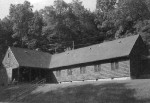Examining ecosystem response to disturbance in a landscape context
Coweeta LTER researchers are examining three linked components of the landscape upland forests, riparian zones, and streams
The presence of rhododendron in the Southern Appalachian riparian zone may alter hillslope export of carbon and nutrients to streams
By Judy L. Meyer and Wayne T. Swank
Coweeta Hydrologic Laboratory, located in the Southern Appalachians, has been administered by the USDA Forest Service since its establishment in 1934. The site contains stands of eastern deciduous forest of varying age at elevations from 680 to 1590 m, white pine plantations and 73 km of streams. LTER research at Coweeta Hydrologic Laboratory focuses on studies along complex environmental gradients to examine ecosystem response to disturbance in a landscape context. Coweeta LTER researchers, including scientists from University of Georgia, Virginia Tech, Duke University, and the U.S. Forest Service, are examining three linked components of the landscape: upland forests, riparian zones, and streams.
Forests
One of the hypotheses structuring our work on forest ecosystems at Coweeta is that community and ecosystem dynamics in representative forest community types change with position along an environmental (elevational) gradient. We have established five fully instrumented study plots (climate stations, seed and litter traps, throughfall collectors, soil lysimeters, dendrometers) along the altitudinal gradient: xeric oak-pine (782 m), cove hardwood (795 m), low-elevation mixed oak (865 m), high elevation mixed oak (1,001 m), and northern hardwood (1,347 m).
Macro-scale climatic data indicate a strong gradient in precipitation and temperature among the plots, with high-elevation plots receiving more precipitation and experiencing lower air temperatures. Topography, soils, and vegetation mediate these macroclimatic factors
to produce plot-level microclimatic gradients that differ from macro-climatic gradients. For example, soil moisture is greatest on the low-elevation cove hardwood site. Watershed-scale nutrient budgets and plot-level responses do not necessarily agree. For example, at the watershed scale, N budgets indicate very similar N fluxes on high- versus low-elevation watersheds. However, N-mineralization rates are much greater at the high- elevation northern hardwoods site; yet this elevated N is not being stored in the vegetation. It appears that at the watershed scale, these plot-level responses are being dampened. A system of extensive plots over the gradient provides a measure of spatial variability for select processes.
To addition to studies of production, decomposition and biogeochemistry, we are developing models of population dynamics for dominant tree species and quantifying biodiversity of the forest floor fauna, both invertebrates and small mammals. The population models focus on seedling recruitment predicted from a model of seed source strength and dispersal. Modelled seed rain has been used to partition the extent to which seed availability regulates recruitment along the gradient. Additional studies along the gradient include studies of below-ground and canopy communities. Analyses of the dynamics of roots and rhizosphere communities are being examined using root boxes, and canopy arthropod communities are being studied using canopy walkways, recently featured on a segment of a CNN news program.
Coweeta experienced a severe drought in the late 1980s. A major impact of this drought was the death of pines (Finns rigida) and oaks (Quercus coccinea), which created gaps in the forest canopy. To understand the long-term response of the vegetation to this natural disturbance, we have initiated a set of experiments to test the hypothesis that elevation and the presence of rhododendron influence succession in canopy gaps. Experimental gaps in the canopy were created by girdling trees in 1993 after collecting pre-treatment data on light, climate, soil moisture and N mineralization, tree growth, and seedling physiology. These gaps are at high and low elevations, with and without rhododendron in the understory.
Riparian Zone
Riparian zones form critical linkages between forest and stream ecosystems. We hypothesize that in the Southern Appalachians, the presence of rhododendron in the riparian zone alters hillslope export of carbon and nutrients to streams. We are in the second year of the pretreatment phase of a vegetation manipulation experiment in which we will remove riparian rhododendron and examine the impact of removal on export of nutrients and organic matter using a model of hillslope hydrology and nutrient transport to interpret the data.
Streams
Our current LTER studies on streams are designed to determine the longitudinal patterns of stream populations and ecosystems that are controlled by changes in geomorphology. We are sampling at four representative sites along Ball Creek as defined by a principal components analysis of geomorphic survey data. The four sites differ in hydrologic parameters, amount of woody debris, and standing stock of benthic organic matter. Gross primary productivity and fish production vary several-fold over the gradient, but there is less variation in litter input, invertebrate production, leaf decay rate, and benthic respiration. The physical template is more variable than the ecological response. One of the unique aspects of this study is that we have measured both invertebrate and fish biomass and production. At one site, fish biomass exceeds invertebrate biomass. How can the biomass of a predator exceed that of its prey? Because prey production exceeds predator production by at least an order of magnitude. Hence, when trying to understand trophic relationships, it is essential to compare production rather than biomass.
Additional Research
In addition to the LTER research described above, there are over 25 other projects at Coweeta funded by NSF, Forest Service, EPA, and other agencies and institutions doing research that complement the LTER studies. These projects include an ecosystem management demonstration project on a nearby watershed, an analysis of the response of Southern Appalachian forests to burning as a technique of site preparation, and a study of the community and ecosystem responses of streams to elimination of leaf litter inputs.
For more information: Judy Meyer, Institute of Ecology, University of Georgia, Athens GA 30602-2 602 or Wayne Swank, Coweeta Hydrologic Laboratory, 999 Coweeta Lab Road, Otto NC 28763

 Enlarge this image
Enlarge this image

